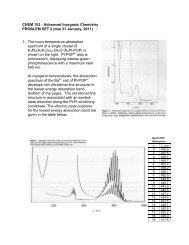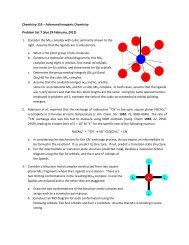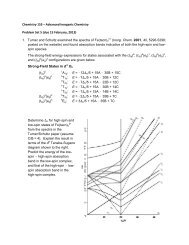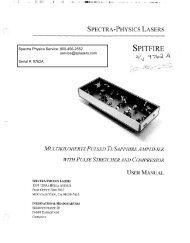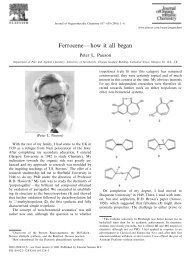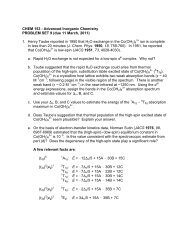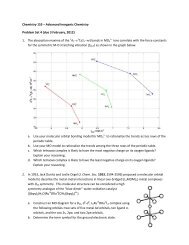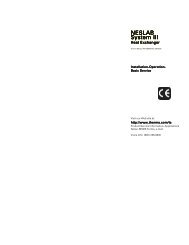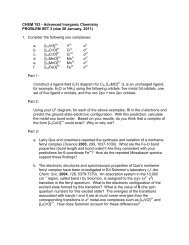Tsunami - Beckman Institute Laser Resource Center
Tsunami - Beckman Institute Laser Resource Center
Tsunami - Beckman Institute Laser Resource Center
Create successful ePaper yourself
Turn your PDF publications into a flip-book with our unique Google optimized e-Paper software.
<strong>Tsunami</strong><br />
The modulation frequency 2wmL must be precisely matched to the repetition<br />
rate of output pulses which is C/2L. The rf signal used to drive the - -<br />
AOM is, thus, usually generated by a temperature-stabilized crystal oscillator,<br />
and the cavity length of the laser is adjusted to obtain the appropriate<br />
frequency.<br />
The duration of the mode-locked pulses depends on several factors including<br />
the gain bandwidth of the laser and the modulation depth of the AOM.<br />
<strong>Laser</strong> media with greater gain bandwidth have the capability of generating<br />
shorter pulses. Consequently, active mode locking a Nd:YAG laser produces<br />
pulse widths of 30 to 150 ps, while for an ion laser, durations are<br />
usually 120 to 200 ps.<br />
In passively mode-locked systems, the pulse itself generates the periodic<br />
modulation. This can be accomplished with a saturable absorber dye that<br />
responds to the instantaneous light intensity in a nonlinear manner. At low<br />
light intensity the dye is opaque, but at higher intensities the dye is bleached<br />
and becomes transparent. The bleaching time of the dye is the effective time<br />
of the optical shutter. In the 1980's, a colliding pulse geometry was used<br />
with the passive mode locking technique to produce a colliding pulse modelocked<br />
(CPM) dye laser. When intracavity GVD compensation (described<br />
laser in this chapter) was used with a CPM laser, sub-100 fs pulses were<br />
generated for the first time.<br />
Also, during the 198OYs, several new developments in broad bandwidth,<br />
solid-state laser materials occurred. The most notable of these was<br />
titanium-doped sapphire which allowed lasers to be tuned over a continu- -<br />
ous range from < 700 to 1100 nm. In 1989, Spectra-Physics was the first<br />
company to offer a commercial cw Ti:sapphire laser.<br />
The broad bandwidth and good thermal properties of this new material<br />
motivated several new mode locking approaches. Additive pulse mode<br />
locking (APM) used an interferometrically-coupled, external nonlinear<br />
fiber cavity to induce mode locking. In 1991, self-mode locking in<br />
Tisapphire was observed to be induced through the intensity-dependent,<br />
nonlinear refractive index of the laser medium. At Spectra-Physics <strong>Laser</strong>s<br />
we developed the <strong>Tsunami</strong> laser, a commercial, mode-locked Ti:sapphire<br />
laser based upon a regeneratively initiated technique.<br />
Regenerative Mode Locking in <strong>Tsunami</strong><br />
Like active mode locking, regenerative mode locking in the <strong>Tsunami</strong> laser<br />
employs an AOM within the cavity to generate a periodic loss. However,<br />
unlike active mode locking, the rf drive signal used to drive the AOM is<br />
derived directly from the laser cavity (Figure A-4). This removes one of<br />
the greatest drawbacks of active mode locking, i.e., the requirement that<br />
the cavity length match the external drive frequency. In the <strong>Tsunami</strong>, if the<br />
laser cavity length L changes slightly, the drive signal to the modulator<br />
changes accordingly.<br />
When the <strong>Tsunami</strong> is initially aligned, the laser is operating cw with - -<br />
oscillations from several longitudinal modes. These are partially phase-



